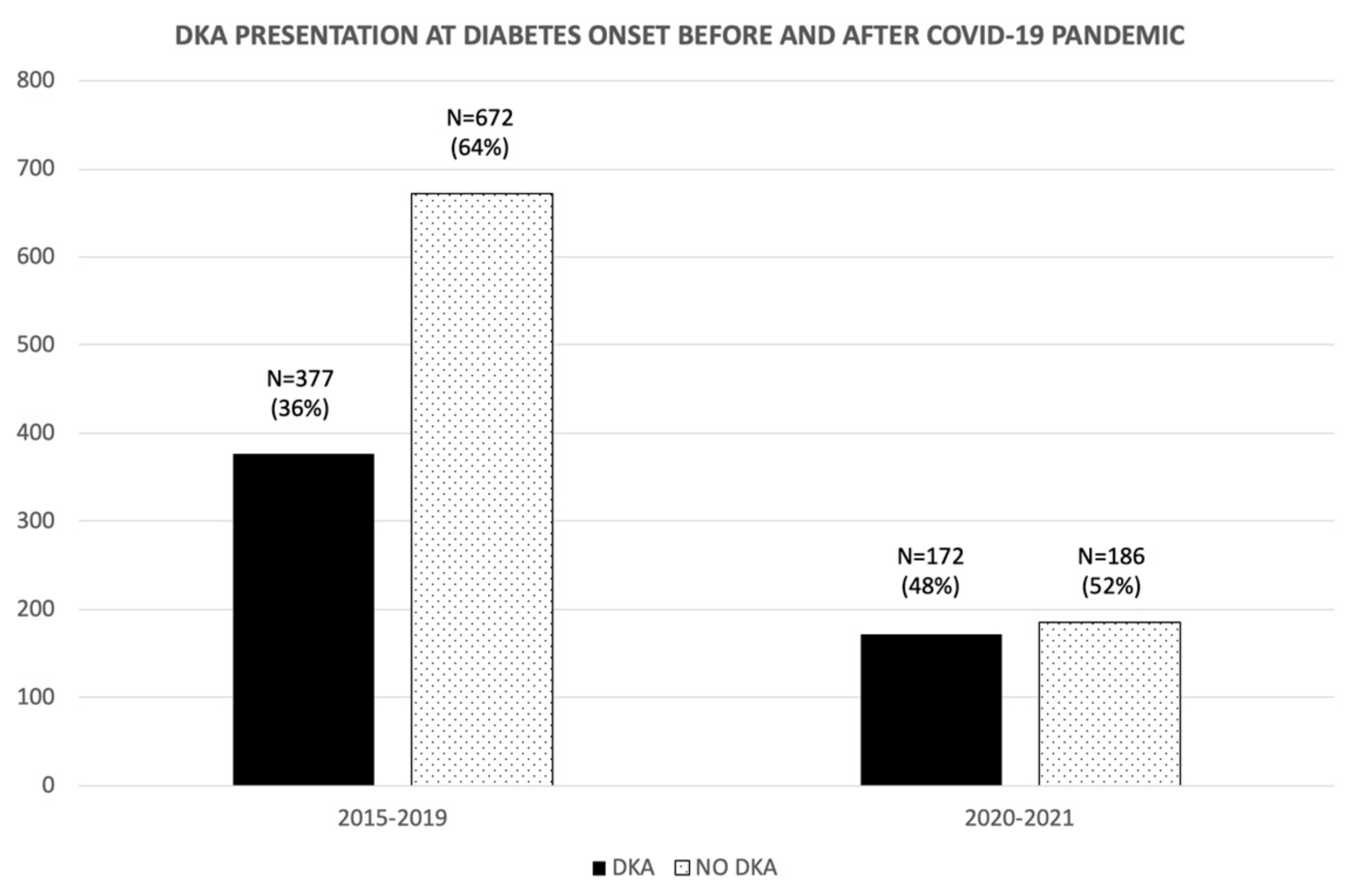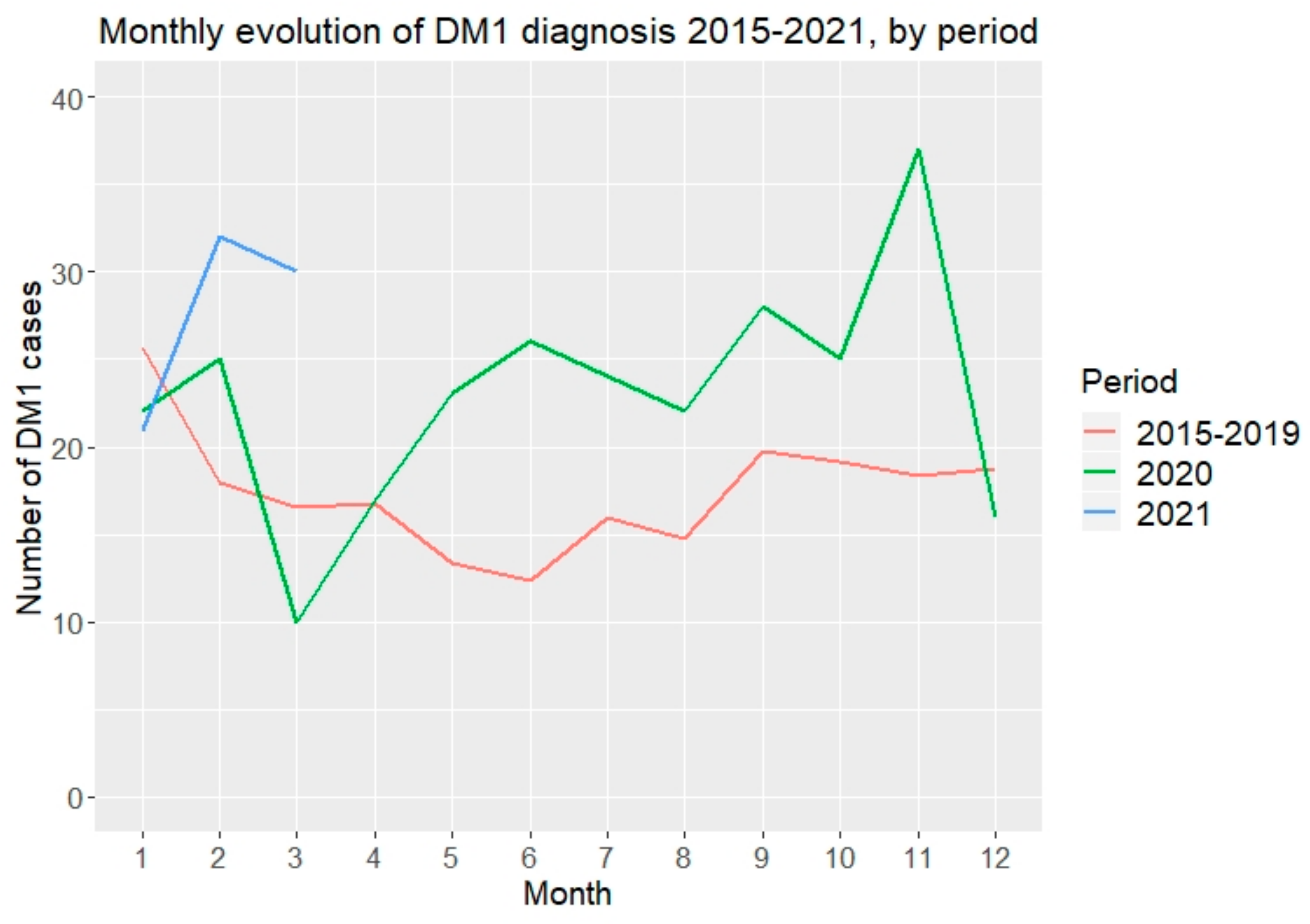Increased Presentation of Diabetic Ketoacidosis and Changes in Age and Month of Type 1 Diabetes at Onset during the COVID-19 Pandemic in Spain
Abstract
:1. Introduction
2. Research Design and Methods
3. Results
4. Discussion
Author Contributions
Funding
Informed Consent Statement
Acknowledgments
Conflicts of Interest
References
- Barreiro, S.C.; Rodríguez, M.R.; Lozano, G.B.; Siguero, J.L.; Pelegrín, B.G.; Val, M.R.; Dea, M.L. Epidemiología de la diabetes mellitus tipo 1 en menores de 15 años en España. An. Pediatr. 2014, 81, 189.e1–189.e12. [Google Scholar]
- Nóvoa Medina, Y. Evolución de la incidencia de la diabetes mellitus tipo 1 en edad pediátrica en España. Endocrinol. Diabetes Nutr. 2018, 65, 65–67. [Google Scholar] [CrossRef] [PubMed]
- Spiteri, G.; Fielding, J.; Diercke, M.; Campese, C.; Enouf, V.; Gaymard, A.; Bella, A.; Sognamiglio, P.; Moros, M.J.S.; Riutort, A.N.; et al. First cases of coronavirus disease 2019 (COVID-19) in the WHO European Region, 24 January to 21 February 2020. Eurosurveillance 2020, 25, 2000178. [Google Scholar] [CrossRef] [PubMed]
- Khunti, K.; Del Prato, S.; Mathieu, C.; Kahn, S.E.; Gabbay, R.A.; Buse, J.B. COVID-19, Hyperglycemia, and New-Onset Diabetes. Diabetes Care 2021, 44, 2645–2655. [Google Scholar] [CrossRef]
- Boddu, S.K.; Aurangabadkar, G.; Kuchay, M.S. New onset diabetes, type 1 diabetes and COVID-19. Diabetes Metab. Syndr. Clin. Res. Rev. 2020, 14, 2211–2217. [Google Scholar] [CrossRef] [PubMed]
- Unsworth, R.; Wallace, S.; Oliver, N.S.; Yeung, S.; Kshirsagar, A.; Naidu, H.; Kwong, R.M.W.; Kumar, P.; Logan, K.M. New-Onset Type 1 Diabetes in Children During COVID-19: Multicenter Regional Findings in the UK. Diabetes Care 2020, 43, e170–e171. [Google Scholar] [CrossRef] [PubMed]
- Kamrath, C.; Mönkemöller, K.; Biester, T.; Rohrer, T.R.; Warncke, K.; Hammersen, J.; Holl, R.W. Ketoacidosis in Children and Adolescents with Newly Diagnosed Type 1 Diabetes during the COVID-19 Pandemic in Germany. JAMA 2020, 324, 801. [Google Scholar] [CrossRef] [PubMed]
- Güemes, M.; Storch-de-Gracia, P.; Enriquez, S.V.; Martín-Rivada, Á.; Brabin, A.G.; Argente, J. Severity in pediatric type 1 diabetes mellitus debut during the COVID-19 pandemic. J. Pediatr. Endocrinol. Metab. 2020, 33, 1601–1603. [Google Scholar] [CrossRef]
- Rabbone, I.; Schiaffini, R.; Cherubini, V.; Maffeis, C.; Scaramuzza, A.; The Diabetes Study Group of the Italian Society for Pediatric Endocrinology and Diabetes. Has COVID-19 Delayed the Diagnosis and Worsened the Presentation of Type 1 Diabetes in Children? Diabetes Care 2020, 43, 2870–2872. [Google Scholar] [CrossRef]
- Lawrence, C.; Seckold, R.; Smart, C.; King, B.R.; Howley, P.; Feltrin, R.; Smith, T.A.; Roy, R.; Lopez, P. Increased paediatric presentations of severe diabetic ketoacidosis in an Australian tertiary centre during the COVID-19 pandemic. Diabet. Med. 2021, 38, e14417. [Google Scholar] [CrossRef]
- Ho, J.; Rosolowsky, E.; Pacaud, D.; Huang, C.; Lemay, J.; Brockman, N.; Rath, M.; Doulla, M. Diabetic ketoacidosis at type 1 diabetes diagnosis in children during the COVID-19 pandemic. Pediatr. Diabetes 2021, 22, 552–557. [Google Scholar] [CrossRef]
- Salmi, H.; Heinonen, S.; Hästbacka, J.; Lääperi, M.; Rautiainen, P.; Miettinen, P.J.; Vapalahti, O.; Hepojoki, J.; Knip, M. New-onset type 1 diabetes in Finnish children during the COVID-19 pandemic. Arch. Dis. Child. 2021, 107, 180–185. [Google Scholar] [CrossRef]
- Mameli, C.; Scaramuzza, A.; Macedoni, M.; Marano, G.; Frontino, G.; Luconi, E.; Pelliccia, C.; Felappi, B.; Guerraggio, L.P.; Spiri, D.; et al. Type 1 diabetes onset in Lombardy region, Italy, during the COVID-19 pandemic: The double-wave occurrence. EClinicalMedicine 2021, 39, 101067. [Google Scholar] [CrossRef]
- Vlad, A.; Serban, V.; Timar, R.; Sima, A.; Botea, V.; Albai, O.; Timar, B.; Vlad, M. Increased Incidence of Type 1 Diabetes during the COVID-19 Pandemic in Romanian Children. Medicina 2021, 57, 973. [Google Scholar] [CrossRef]
- Gottesman, B.L.; Yu, J.; Tanaka, C.; Longhurst, C.A.; Kim, J.J. Incidence of New-Onset Type 1 Diabetes among US Children during the COVID-19 Global Pandemic. JAMA Pediatr. 2022, 176, 414. [Google Scholar] [CrossRef]
- Kamrath, C.; Rosenbauer, J.; Eckert, A.J.; Pappa, A.; Reschke, F.; Rohrer, T.R.; Mönkemöller, K.; Wurm, M.; Hake, K.; Raile, K.; et al. Incidence of COVID-19 and Risk of Diabetic Ketoacidosis in New-Onset Type 1 Diabetes. Pediatrics 2021, 148, e2021050856. [Google Scholar] [CrossRef]
- Tittel, S.R.; Rosenbauer, J.; Kamrath, C.; Ziegler, J.; Reschke, F.; Hammersen, J.; Mönkemöller, K.; Pappa, A.; Kapellen, T.; Holl, R.W. Did the COVID-19 Lockdown Affect the Incidence of Pediatric Type 1 Diabetes in Germany? Diabetes Care 2020, 43, e172–e173. [Google Scholar] [CrossRef]
- American Diabetes Association Professional Practice Committee. 6. Glycemic Targets: Standards of Medical Care in Diabetes—2022. Diabetes Care 2022, 45 (Suppl. S1), S83–S96. [Google Scholar] [CrossRef]
- Wolfsdorf, J.I.; Glaser, N.; Agus, M.; Fritsch, M.; Hanas, R.; Rewers, A.; Sperling, M.A.; Codner, E. ISPAD Clinical Practice Consensus Guidelines 2018: Diabetic ketoacidosis and the hyperglycemic hyperosmolar state. Pediatr. Diabetes 2018, 19, 155–177. [Google Scholar] [CrossRef]
- ISPAD: Summary of Recommendations Regarding COVID-19 in Children with Diabetes. Available online: https://www.ispad.org/page/COVID-19inchildrenwithdiabetesResources (accessed on 29 April 2020).
- Leete, P.; Oram, R.A.; McDonald, T.J.; Shields, B.M.; Ziller, C.; Hattersley, A.T.; Richardson, S.J.; Morgan, N.G.; TIGI Study Team. Studies of insulin and proinsulin in pancreas and serum support the existence of aetiopathological endotypes of type 1 diabetes associated with age at diagnosis. Diabetologia 2020, 63, 1258–1267. [Google Scholar] [CrossRef]
- Kamrath, C.; Rosenbauer, J.; Eckert, A.J.; Siedler, K.; Bartelt, H.; Klose, D.; Sindichakis, M.; Herrlinger, S.; Lahn, V.; Holl, R.W. Incidence of Type 1 Diabetes in Children and Adolescents during the COVID-19 Pandemic in Germany: Results from the DPV Registry. Diabetes Care 2022. Online ahead of print. [Google Scholar] [CrossRef] [PubMed]
- Barrett, C.E.; Koyama, A.K.; Alvarez, P.; Chow, W.; Lundeen, E.A.; Perrine, C.G.; Pavkov, M.E.; Rolka, D.B.; Wiltz, J.L.; Bull-Otterson, L. Risk for Newly Diagnosed Diabetes >30 Days after SARS-CoV-2 Infection among Persons Aged <18 Years—United States, 1 March 2020–28 June 2021. MMWR Morb. Mortal Wkly Rep. 2022, 71, 59–65. [Google Scholar] [PubMed]



| Age (Years) | |||
|---|---|---|---|
| Period | ≤4 Years | 5–9 Years | ≥10 Years |
| 2015–2019 | 204 (19%) | 424 (39%) | 456 (42%) |
| 2020–2021 | 88 (25%) | 108 (30%) | 163(45%) |
Publisher’s Note: MDPI stays neutral with regard to jurisdictional claims in published maps and institutional affiliations. |
© 2022 by the authors. Licensee MDPI, Basel, Switzerland. This article is an open access article distributed under the terms and conditions of the Creative Commons Attribution (CC BY) license (https://creativecommons.org/licenses/by/4.0/).
Share and Cite
Leiva-Gea, I.; Antúnez Fernández, C.; Cardona-Hernandez, R.; Ferrer Lozano, M.; Bahíllo-Curieses, P.; Arroyo-Díez, J.; Clemente León, M.; Martín-Frías, M.; Conde Barreiro, S.; Mingorance Delgado, A.; et al. Increased Presentation of Diabetic Ketoacidosis and Changes in Age and Month of Type 1 Diabetes at Onset during the COVID-19 Pandemic in Spain. J. Clin. Med. 2022, 11, 4338. https://doi.org/10.3390/jcm11154338
Leiva-Gea I, Antúnez Fernández C, Cardona-Hernandez R, Ferrer Lozano M, Bahíllo-Curieses P, Arroyo-Díez J, Clemente León M, Martín-Frías M, Conde Barreiro S, Mingorance Delgado A, et al. Increased Presentation of Diabetic Ketoacidosis and Changes in Age and Month of Type 1 Diabetes at Onset during the COVID-19 Pandemic in Spain. Journal of Clinical Medicine. 2022; 11(15):4338. https://doi.org/10.3390/jcm11154338
Chicago/Turabian StyleLeiva-Gea, Isabel, Cristina Antúnez Fernández, Roque Cardona-Hernandez, Marta Ferrer Lozano, Pilar Bahíllo-Curieses, Javier Arroyo-Díez, María Clemente León, Maria Martín-Frías, Santiago Conde Barreiro, Andrés Mingorance Delgado, and et al. 2022. "Increased Presentation of Diabetic Ketoacidosis and Changes in Age and Month of Type 1 Diabetes at Onset during the COVID-19 Pandemic in Spain" Journal of Clinical Medicine 11, no. 15: 4338. https://doi.org/10.3390/jcm11154338
APA StyleLeiva-Gea, I., Antúnez Fernández, C., Cardona-Hernandez, R., Ferrer Lozano, M., Bahíllo-Curieses, P., Arroyo-Díez, J., Clemente León, M., Martín-Frías, M., Conde Barreiro, S., Mingorance Delgado, A., & Pérez Sánchez, J., on behalf of the Diabetes Group of the Spanish Pediatric Endocrinology Society (SEEP). (2022). Increased Presentation of Diabetic Ketoacidosis and Changes in Age and Month of Type 1 Diabetes at Onset during the COVID-19 Pandemic in Spain. Journal of Clinical Medicine, 11(15), 4338. https://doi.org/10.3390/jcm11154338






